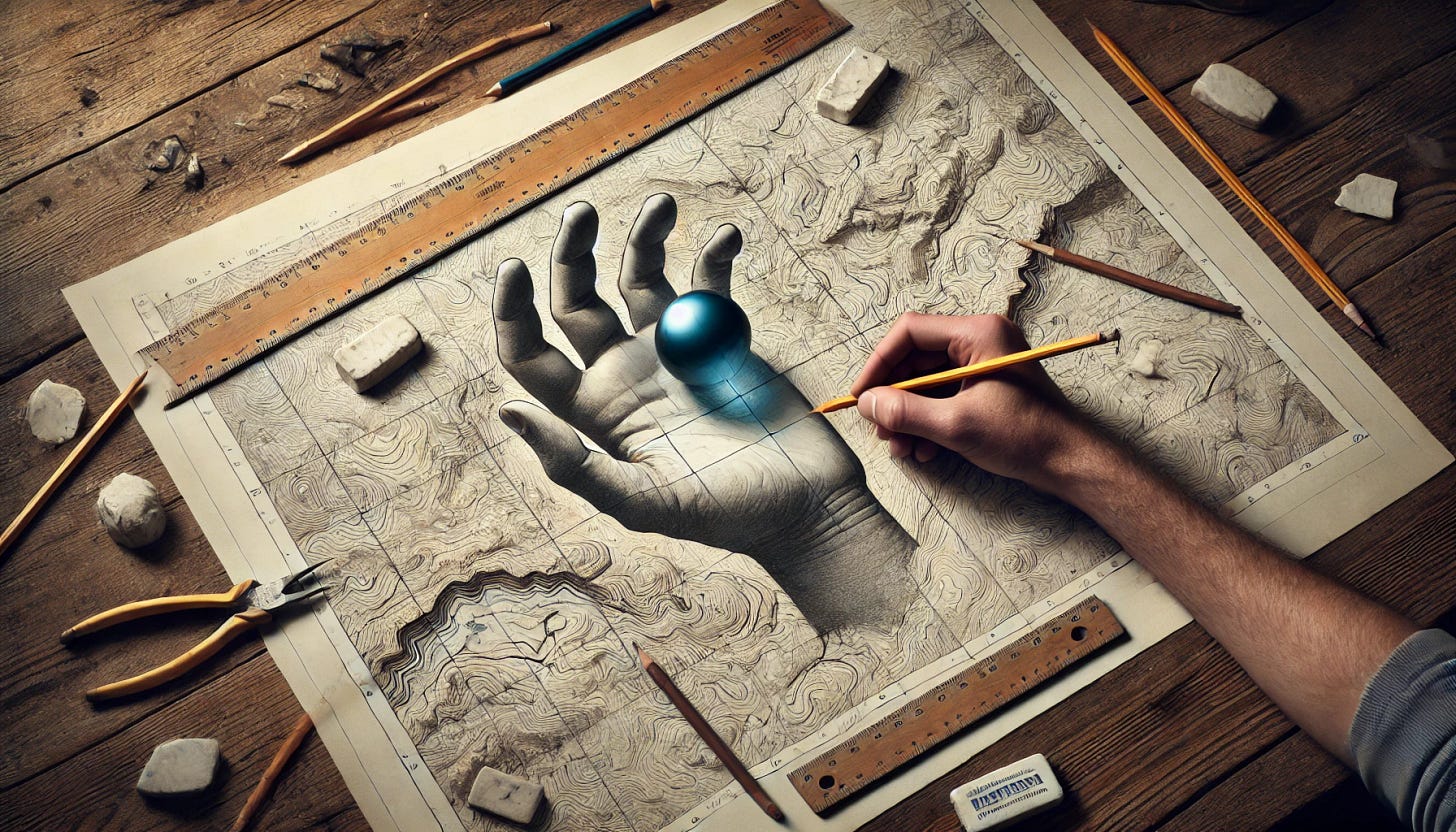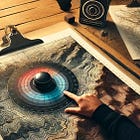Previous post in this series:
Next post:
Now that we have covered the fieldwork mapping process in some depth, and ventured into the territory of coexisting states, we are ready to take another significant step forward in the practice of our science. This step addresses a conundrum that has beset the study and theory of consciousness from the beginning:
Who or what is doing the “observing,” and what is its relationship to that which is observed?
This touches on the perennial homunculus problem, which arises when attempts to explain consciousness posit a smaller "self" or observer within the self, leading to a regress of observers observing observers. Philosophers and scientists have grappled with this for centuries, with modern frameworks increasingly favoring distributed, emergent, and relational models.
Psychotopology fieldwork enables us to walk right into the heart of this mystery to illuminate what’s really there.
Accessing the Witness Self
In order to answer the fieldwork mapping questions, we must access the feeling state directly, being able to feel what it feels like in the moment. At the same time, we must be able to step outside of the feeling state as if to observe it as an object separate from ourselves. The questions support us in doing this, but how? Again, who or what is doing the observing?
As we work our way through the series of questions, we practice a kind of alternating detachment from and immersion within the feeling state. We learn and practice a kind of freedom in our relationship to this feeling state. Over the course of engaging with the questions, and further, over the course of mapping several related feeling states, we develop a strong sense of being a witness to our own interior. For now, we will just call this the witness self.
Your strengthening relationship with this witness self is one of the benefits of fieldwork mapping. There is a clear difference between having a fusion versus a separation between our sense of self and a feeling state we are experiencing. In the first case, it feels like we ARE the feeling state, while in the second, we clearly HAVE the feeling state among other possessions within the whole of our experience.
Having access to such a witness position makes it much easier to engage with feeling states that might otherwise feel too intense to process. Accessing the witness can help keep you from falling into strong states and having difficulty getting back out again. Consciously developing a witness self can also support living with and observing strong patterns of thought, mood, and behavior. This can serve your process in many ways.
First: Becoming Aware of the Witness Self
In Introducing the Structure of Attention, I described how our awareness functions as a field, occupying space while filtering and highlighting selective contents of consciousness available in that space. In my description, I described the experience of “operating” this field as if it were a lab instrument. What I refrained from addressing, however, is this idea of the operator. If our field of awareness is an instrument, collecting observational data, who or what is operating it?
I held back on addressing this latent question because we hadn’t advanced our work far enough for me to explicitly describe the complete structure of the attention function. Now that we’ve come a step closer, we can take a more thorough look at the witness experience.
One component of attention is the field of awareness. But there is very definitely another component that functions as the operator of that field. This is what I’m referring to as the witness.
Where We Are Looking From, Who We Are Looking As
The field of awareness hosts the zone of conscious experience to which we normally devote our attention. In all cases, whether in everyday life as we tell a story of what happened this morning or in the lab as the researcher collects data from a subject with wires coming off of their head, what is considered most important is the contents of our awareness. Here, we will open things up to include more of the complete attentional experience.
First, no matter whether we are gazing at a sunset or reminiscing about a delicious dinner with good friends last week, there is more going on than the simple contents of our awareness.
First, of course, we are looking AT something. This is the primary, habitual focus, the “contents” of our awareness.
Second, we are looking FROM somewhere.
Third, we are looking AS someone.
The second and third components of this attentional structure are central to our experience of the whole. The second component, that of the where from which we are looking, I refer to as the point of witness. The third component, that of the who at the center of our experience, I refer to as the seat of witness.
The Point of Witness
Describing the point of witness will probably best be done by leading you through a couple of simple exercises. Some of you will be able to do both of these relatively easily, but others may have some difficulty. Try them both to get a sense of your own range of motion.
Imagine a forest. First, see it as if on a movie screen in a theater. The point of view is that of a person walking through the forest. Next, enter the forest yourself, so that instead of being projected on a screen, it surrounds you as you walk through the trees. Next, imagine lying down and looking up at the sky through the forest canopy. Finally, separate from your own body and fly up above the forest to look down from a drone’s-eye view, seeing yourself lying on the forest floor.
Imagine a concert. Close your eyes and focus entirely on the sound. First, you are in the audience, surrounded by people, with the musicians on stage in front of you. Next, leave yourself in your seat as you send your center of hearing up on stage, listening to what the concert sounds like from the position of one of the musicians. Next, imagine you are in the basement beneath the concert hall, hearing the music through the structure of the building. Finally, you are completely outside the building, hearing it from outside along with rumbling traffic in the distance.
In both of these cases we are using imagination to gain a separation from the normal entrainment of our senses with the sensory tools of our body. When we see and hear things in everyday life, we tend to see and hear them from a position centered in our own head. In switching to an imaginary scene, we gain more freedom to move about to experience what it is like to “see” and “hear” from different points of view.
Now, in the process of mapping a feeling state, we will be activating a channel of perception that is not as entrained with our sensory apparatus. In exploring the virtual material properties of the state you are mapping, you will have significant freedom to move the place from which you are observing — your point of witness — to wherever it is most useful to observe from.
For some of the mapping questions, you will find it most useful to completely immerse your point of witness within the state space. Temperature is an example of a property that lends itself well to this orientation. For others, you will find it more useful to separate your point of witness from that feeling space and observe it from outside. Color is an example of a property that, for most people, seems to be most easily accessible from a point of view outside the state space.
The mapping questions support your doing this, and going through the mapping questions helps you establish a strong sense of agency in being able to experience this feeling state from different perspectives.
Mapping the Seat of Witness
Again, the best way into the experience of the seat of witness is to simply do the practice, as follows.
Map two or three distinct feeling states.
After finishing your second or third mapping, lead yourself through the following:
As you have gone through the mapping process with these states, you have been able to switch your awareness from one state to the next while managing that process from outside of the states themselves. What would you call the part of yourself that is managing, observing, or witnessing? What part of you is doing the mapping process with these feeling states?
Give that witness/observer part of you a name. (It could be anything from “My Witness Self” or “Observer” to “Me.”)
Map this witness self, following the same mapping sequence you used with the other feeling states.
Your greatest ally in working with all kinds of inner material is your own capacity for witness observation. Being able to access a feeling state while situating your experience of self as an observer, outside of it, will get you through mapping even the most difficult states.
Fieldwork itself will develop a stronger witness awareness within you. Starting small and focusing on lower-intensity feeling states early on can give you the opportunity to more strongly develop this witness awareness by explicitly mapping it in this way. Once you have done so, you can use this map of your witness self to access this part of you clearly and strongly before you begin mapping in future sessions. Even more important, use it after each session to step clearly out of the mapping process.
If you find yourself at some point expanding your exploration into realms less common or familiar to you, or more deeply hidden from your everyday awareness, you may need to re-do this witness mapping process. The witness does not occupy a fixed location, but situates itself within different parts of you depending on what larger pattern is engaged relative to the context you’re inhabiting.
You’ll learn much more about the witness and how it works down the line. For now, this simple strategy should be enough to serve you as move forward.
Pro Tip: Map the Witness of the Witness?
In order to map the witness self, you had to step outside of that as well. What would you name the witness of the witness? You can also map this.
You might think this would lend itself to endless iteration, hurling us back into the homunculus regression, but generally the third witness is as far as you will be able to go. Often, that third witness is experienced as a profound universal consciousness kind of state. It’s worth exploring if you’re so inclined.
Reflections
In the course of this series on fieldwork mapping, I would like to ask for your feedback about how well you are able to put these instructions to work. Where do you struggle, what comes easily, and what suggestions do you have for improving how this series supports you and others in doing the mapping? Thank you!
And of course, if you have not yet subscribed and would like make sure to keep up with this series and beyond, please do subscribe. Consider signing up for a paid subscription to participate in the live Engage meetings, where you’ll be able to get your questions answered and more.




